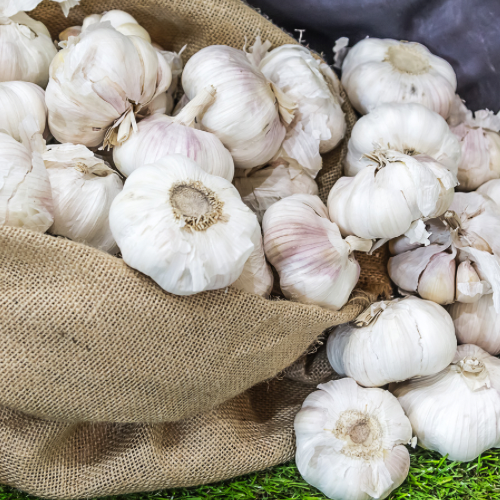Recognizing the key indicators of a garlic bulb being harvest-ready enables garlic to achieve optimal flavor and maximize its storage potential. If you’re wondering, “How to tell when garlic is ready to harvest?”, then this practical guide is here to keep you from making the common mistakes that lead to undersized or spoiled garlic crops.
How to Tell When Garlic Is Ready to Harvest
Key signs it's time to harvest garlic are when you observe yellowing and browning of lower leaves, curling of the garlic scape, and growth of properly sized bulbs with firm stems, distinct cloves, and intact wrappers. Timing these observations with the seasonal growth timeline, typically harvested early to mid-summer, can help collect mature, well-developed garlic.

Harvesting too early results in underdeveloped bulbs with weak flavor and poor storage potential. Harvesting too late can lead to split bulbs, bruising, staining, and a reduced shelf life. This article will guide you through the signs and methods to determine the optimal time to harvest your garlic to achieve a bountiful and flavorful yield.
Ways to Determine if Garlic Is Ready to Harvest
Garlic plants provide several visual and even tactile clues that signal their readiness for harvest.
1. Look for Yellowing and Browning Leaves
One of the most prominent indicators of garlic maturity is the gradual yellowing and browning of the leaves. This indicates the plant is focusing energy on bulb development.
- This process typically begins with the oldest, lower leaves and progresses upwards.
- Aim for approximately half to two-thirds of the lower leaves to be yellow or brown.
- Don't wait until the leaves are completely brown, signaling over-maturity.
- Avoid harvesting when only a few leaves are yellow early in the season.
2. Monitor the Condition of the Scape
Hardneck garlic varieties produce a stalk called a scape. You can use the scape to determine when your garlic is ready to harvest. Watch for these changes:
|
Scape Appearance |
Meaning |
|
Straight and soft |
Bulb is still growing |
|
Curled yet firm |
Bulb is close to maturity, time to cut scape |
|
Tip standing upward |
You can still cut the scape, but a little late |
3. Observe Bulb Size
Size matters for garlic harvest. When deciding if your garlic is ready, take a close look at the bulbs themselves.
- Garlic bulbs should be plump and well-formed.
- Bulbs that are too small may need more time. Garlic that is too mature, with split skins, may be past its prime.
- A good time to harvest is when the bulbs have reached a good size, often about the width of a golf ball or slightly larger.
- If the cloves inside are starting to separate, you should harvest them soon.
4. Check for Paper-Like Bulb Wrappers
As the garlic bulb matures, it develops protective layers of papery skin, known as wrappers. Ideally, bulbs should have several layers of intact wrappers at harvest.
- Mature bulbs develop dry, papery wrappers.
- Wrappers protect the cloves and promote good storage.
- Immature garlic has thin, easily damaged wrappers.
- Over-mature garlic may have deteriorating or split wrappers.
5. Inspect for Softening and Falling Over of the Top Growth
Another key visual cue, particularly noticeable in the final stages of maturity, is the softening and eventual falling over of the top growth or stalk of the garlic plant, just above the bulb.
- The stalk above the bulb will begin to soften.
- The top growth will eventually bend or fall over.
- This signifies that bulb development is nearing completion.
- Harvest within a week or two of lodging for optimal quality.
6. Confirm Seasonal Timing and Growth Timeline
While visual cues are paramount, understanding the general seasonal timing and growth timeline for garlic in your region can provide a helpful framework, whether your bulbs are best planted in spring or fall. To give you an idea, here's the general timeline for most temperate climate regions in the Northern Hemisphere, like here on our Wisconsin farm.
|
Stage |
Timing |
|
Planting |
Fall (September to November) |
|
Sprouting |
Early spring (February to April) |
|
Bulb formation |
Late spring to summer (May to July) |
|
Harvest |
Mid-late summer (July to September) |
Garlic Variety Readiness
Another way to determine the right time to harvest garlic is to understand that garlic varieties mature at slightly different times.
1. Softneck Garlic
Softneck garlic varieties, like Inchelium Red and Armenian varieties, generally mature slightly later than hardnecks and do not produce true scapes. The primary indicators of softneck harvest readiness are the yellowing and browning of the lower leaves, as well as the softening and falling over of the top growth.

Since they don't have scapes, you'll need to rely more heavily on the leaf color and the condition of the stalk. Softneck varieties are often ready when about half to two-thirds of their leaves have yellowed.
2. Hardneck Garlic
Hardneck garlic includes varieties like Siberian and Music garlic. These types grow a central stalk, called a scape, which starts to curl into loops as it matures.

When the lower two leaves are dry and a third is turning brown, the bulbs are usually ready to harvest. This is the best stage to get firm, full bulbs.
Gentle Dig Test on Garlic Harvests
While the visual cues provide valuable information, another definitive way to determine if your garlic is ready to harvest is to perform a "gentle dig test".
- Carefully dig up a few sample bulbs.
- Look for well-defined and plump cloves.
- Check for dry and intact wrappers.
- Small cloves or thin wrappers indicate that the garlic needs more time. Splitting bulbs or stained wrappers suggests over-maturity.
Related Questions
Can Garlic Be Left in the Ground for Too Long?
It's not ideal to leave garlic in the ground too long because it can split open, become susceptible to disease, and lose its protective wrappers. Once the outer wrappers deteriorate or the bulbs split apart, you've waited too long and should harvest immediately to salvage what you can.
What Happens if You Pull Garlic Too Early?
Pulling garlic too early results in undersized bulbs with underdeveloped cloves that lack the rich flavor profile, storage capacity, and nutritional value of mature garlic. These premature bulbs will have less robust flavor, smaller size, and won't store as long.
How Long Do You Have to Leave Garlic After Harvest?
After harvesting garlic, it should be cured in a dry, well-ventilated area out of direct sunlight for approximately 2-3 weeks until the necks are completely dry and the outer wrappers become papery. This curing process allows excess moisture to evaporate, concentrates the flavor, and prepares the bulbs for long-term storage.
Conclusion
With the right information on when to harvest garlic, you'll be rewarded with perfectly formed bulbs instead of buying them. Watch for those telltale signs in your garden and enjoy the satisfaction of pulling perfect garlic bulbs at precisely the right moment.


